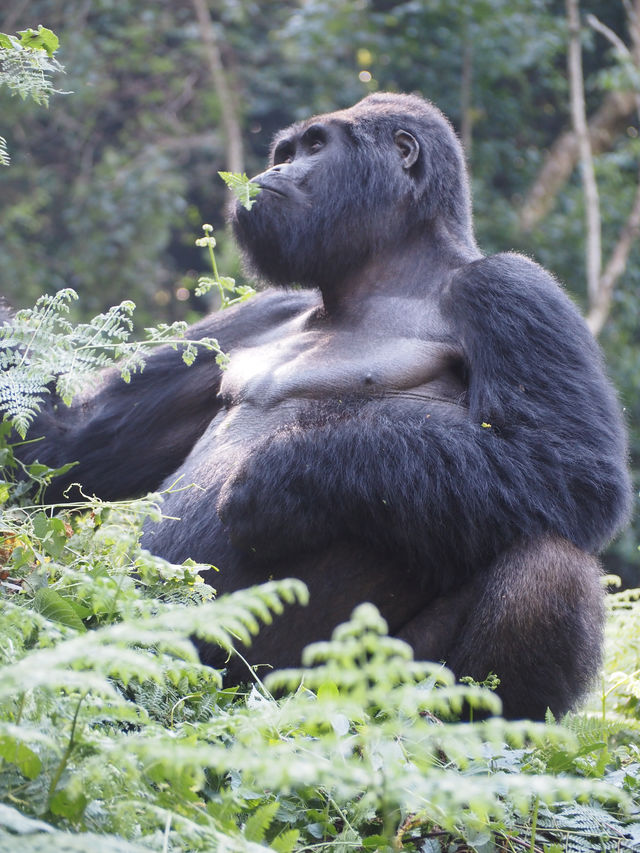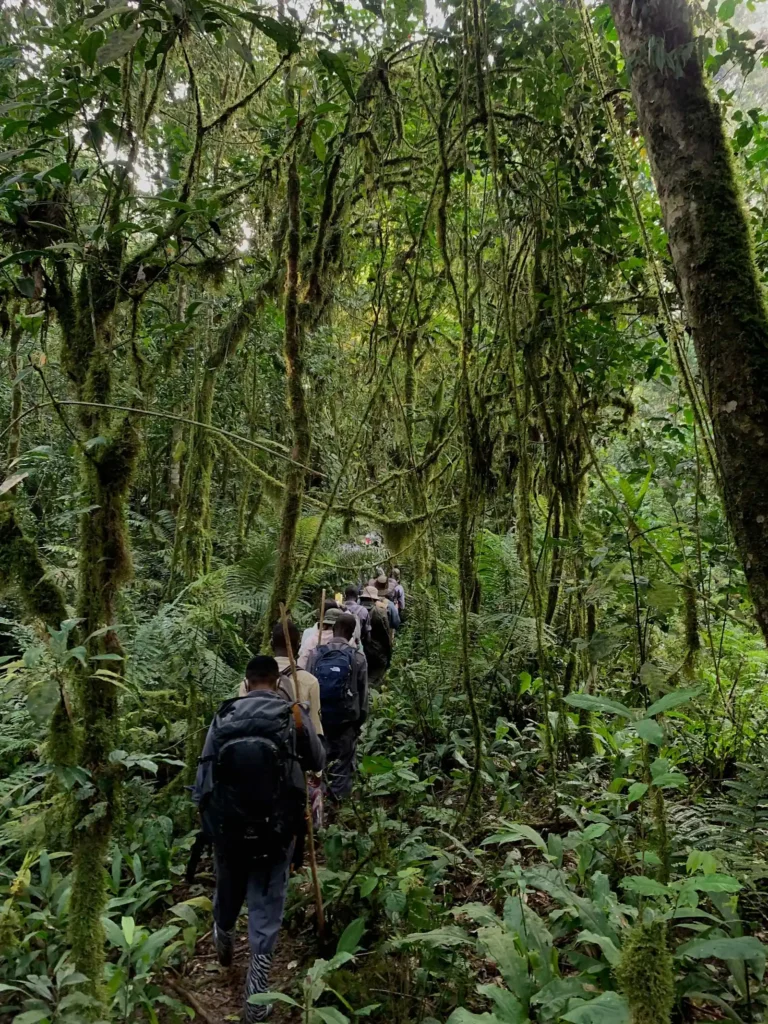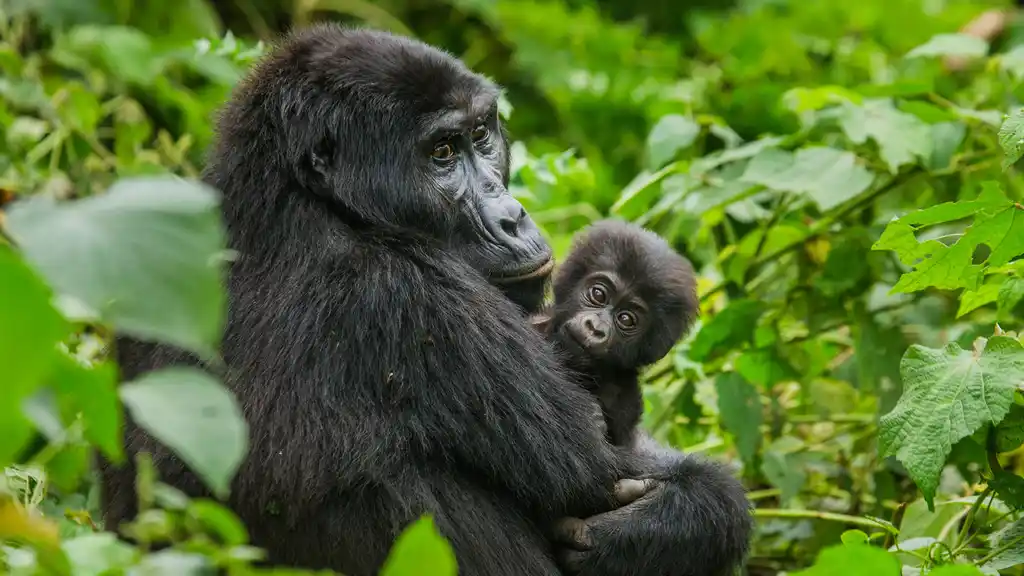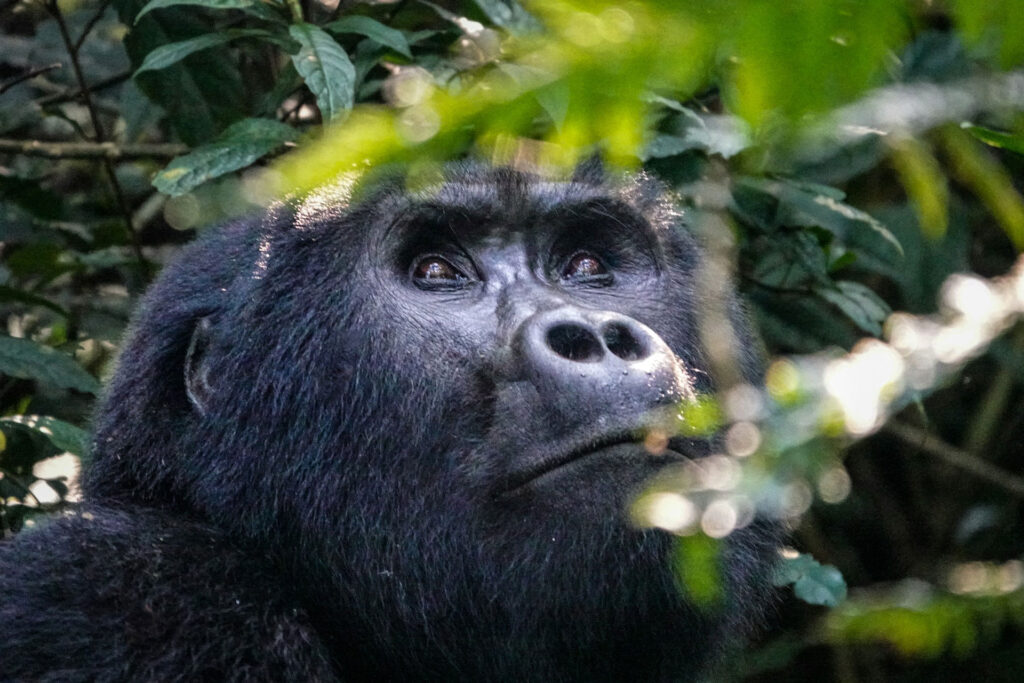Bwindi Impenetrable National Park – or just Bwindi to make things shorter – is a thick rainforest high in the mountains of southwestern Uganda. This ancient, UNESCO World Heritage-listed jungle is one of the best places in the world to see wild gorillas. Bwindi is home to around 500 mountain gorillas—almost half of all the mountain gorillas on Earth!
There are 26 gorilla families here that are habituated, which means you can safely visit them. That’s more than anywhere else in Africa! Gorilla trekking in Bwindi National Park is a once-in-a-lifetime adventure. It involves hiking through the dense jungle for about 2 to 6 hours until you come face-to-face with a family of gorillas.
Watching them play, rest, and care for each other is deeply moving. These gentle giants share 98% of their DNA with humans, and seeing them up close is often described as life-changing. Best of all, a Bwindi gorilla trekking tour can be organized for a fraction of what it costs in neighbouring Rwanda. A permit here costs $800, compared to $1,500 in Rwanda’s Volcanoes National Park—making Uganda the best-value destination for this rare wildlife encounter.
What are the gorilla trekking sectors in Bwindi?
Bwindi is divided into four main gorilla trekking sectors: Rushaga, Buhoma, Ruhija, and Nkuringo. Each is named after a nearby village and offers a unique trekking experience. Each sector has its own lodges, trails, and access routes, so where you trek depends on your fitness level, the views you want, and where you’re staying.
- Rushaga Sector – Located in the south, Rushaga has the most gorilla families (10 in total). It’s also the only sector where you can do the Gorilla Habituation Experience, which lets you spend up to four hours with a gorilla group still getting used to humans.
- Buhoma Sector – Found in the north, Buhoma is the oldest and most popular sector. It’s home to 7 gorilla families and has the best tourist facilities. It’s also the easiest to reach from Kampala, Entebbe, or Queen Elizabeth National Park.
- Ruhija Sector – Located in the east, Ruhija is quiet and peaceful, with 4 gorilla families. It’s great for people who love birdwatching and don’t mind a bit of a hiking challenge.
- Nkuringo Sector – In the southwest, Nkuringo also has 4 families. It’s known for being the most scenic and most physically demanding sector.


When to go Gorilla Trekking in Bwindi?
You can go gorilla trekking in Bwindi anytime during the year, and chances are very high that you will see the gorillas! But the best time to visit is during the dry seasons, which run from June to August and December to February. During these months, the trails are drier and easier to walk on, making your trek much more comfortable.
In the wet seasons, the trails can get muddy and slippery, which can make the hike a bit hard. Since seeing gorillas is often a once-in-a-lifetime trip, rain might feel frustrating. But don’t worry! The expert guides know how to handle this—they will wait for the rain to stop or slow down before continuing, so you still get a great chance to meet the gorillas.
How to Get to Bwindi National Park
Getting to Bwindi takes some planning because it’s a bit remote—but the journey is definitely worth it! If you’re starting from Kampala (Uganda’s capital) or Entebbe International Airport, expect a long drive of about 10 hours without stops. The roads are mostly paved but can get rough closer to the park.
Want to skip the long drive? Many travelers fly instead! There are two small airstrips nearby:
- Kihihi Airstrip for Buhoma and Ruhija sectors
- Kisoro Airstrip for Rushaga and Nkuringo sectors
Flights from Entebbe take around 1.5 hours, then you’ll enjoy a short scenic drive to your lodge.
If you are coming from Rwanda, good news—Bwindi is closer to Kigali than Kampala! The drive from Kigali takes about 4 to 5 hours, making it a popular and quicker option. Plus, with an East African Tourist Visa, you can easily visit both countries.
Other nearby parks? You can easily combine Bwindi with:
- Queen Elizabeth National Park (3–6 hours by road)
- Lake Mburo National Park (5–7 hours)
- Mgahinga Gorilla National Park (1–2 hours)
- Kibale Forest National Park (6–7 hours)
A few travel tips:
- A 4×4 vehicle is highly recommended, especially in rainy seasons when roads get muddy.
- Always travel during daylight—night driving on rural roads can be tricky.
- Hiring a driver or booking a tour can make your trip smoother since public transport is limited and unreliable here.
Are mountain gorillas aggressive?
No, mountain gorillas are not aggressive at all. They are often called “gentle giants” because, despite their huge size and strength, they are usually calm and peaceful. If they were aggressive, it would be too dangerous to get close to them.
Sometimes, male gorillas may show aggression towards other males, especially when they are competing to lead the group. These fights are rare and usually end with one gorilla leaving peacefully. In very rare cases, these battles can cause serious injury—but this only happens between gorillas, never with people.
Sometimes a gorilla might pretend to charge at visitors as a way to say “I’m in charge,” but it’s usually just a bluff. No tourist has ever been hurt during these moments. Before your gorilla trek in Bwindi, an expert ranger will give you a safety briefing. They will explain exactly what to do if a gorilla comes close. As long as you listen to your guide and follow the rules, you will be completely safe—and ready to enjoy this unforgettable experience.

How Much Does Gorilla Trekking in Bwindi Cost?
A gorilla trekking permit in Bwindi costs $800 for foreign nonresident visitors. It might sound pricey, but it’s actually cheaper than in Rwanda, where permits cost $1,500. Rwanda is the only other safe place where you can see mountain gorillas in the wild.
There are special discounts for some groups:
- $700 for foreign residents living in Uganda
- $80 for citizens of East African countries
- $500 for holders of other African passports
In Uganda, you can trek gorillas in two parks: Bwindi Impenetrable National Park and Mgahinga Gorilla National Park. Both let groups of up to eight people spend one hour with a gorilla family once they find them.
Bwindi also has a unique experience called the Gorilla Habituation Experience. Here, smaller groups of four people can spend up to four hours with gorillas that are still getting used to humans. Because these gorillas aren’t fully comfortable with people yet, they might stay a bit farther away, so sightings can be trickier. This special trip costs $1,500.
How to Book a Gorilla Permit for Bwindi?
Gorilla permits for Bwindi are very limited and sell out fast—especially during the busy months of June to August and December to February. To make sure you don’t miss out, it’s best to book your permit 3 to 6 months before your trip. When you book, pick the sector where you’ll be staying—like Buhoma, Ruhija, Rushaga, or Nkuringo—because permits are tied to specific areas. This way, your trekking is easy and hassle-free, with no extra travel time.
Always use a trusted tour operator to get your permit. A good company will secure your permit and take care of all the details for you. For example, Choose Uganda Safaris can hold your permit for seven days with no risk, so you’re sure to get it when you book your trip with them.
When Does the Gorilla Trek in Bwindi Start?
On the day of your gorilla trek in Bwindi, you will leave your lodge early—usually around 6:00 a.m. with a packed lunch in hand. You will head to the park headquarters to register and check your documents. At 8:00 a.m., you will join a short but important briefing led by expert guides and park rangers. They will tell you which gorilla family you will visit and explain the rules to keep you and the gorillas safe. After the briefing, your amazing trek begins—get ready for an unforgettable adventure deep in the forest!
Are the hiking trails in good condition?
Mountain gorillas don’t follow set paths—they roam freely through the forest. Your guide will lead you along established trails, but as you get closer to the gorillas, you will often leave the main paths to push through thick undergrowth. The expert trackers will clear branches with machetes, making the way as easy as possible—but remember, Bwindi means “impenetrable” for a reason!
The forest is dense and wild, and even the official trails can be overgrown, muddy, and slippery, especially after rain. That’s why hiring a porter is a smart move. Porters carry your gear and offer a helping hand on tricky sections, making your trek safer, smoother, and way more enjoyable.
Can People with Disabilities Go Gorilla Trekking in Bwindi?
Absolutely! People with disabilities can enjoy gorilla trekking in Bwindi using a special sedan chair. This chair is carried by a team of trained local porters who help you move safely and comfortably through the steep, rugged forest trails.
This way, everyone gets the chance to see the amazing mountain gorillas up close. The gorilla trekking permit costs $800, and hiring the sedan chair and porters usually adds about $300. This not only makes the trek possible for those with mobility challenges but also helps support local families who protect the gorillas and the forest. With good planning and help from tour companies like Greenway Nature Tours Africa, a memorable gorilla trekking adventure is within reach for everyone.
Can children go gorilla trekking in Bwindi National Park?
Children under 15 years old are not allowed to go gorilla trekking in Bwindi. This rule helps keep both the visitors and the gorillas safe. The hike can be hard—it’s steep, muddy, and sometimes slippery, which can be too much for young kids. Also, while mountain gorillas are calm and peaceful, they are still very big and powerful.
A male silverback gorilla can weigh up to 200 kilograms (about 440 pounds). If a gorilla ever feels threatened, it may do a mock charge to scare the group. Adults are taught to stay calm, but a child might scream or run, which could cause the gorilla to actually give chase. For this reason, only those aged 15 and above are allowed to trek.
However, in some cases, kids as young as 13 may join with special permission and a letter from their parents. If you are traveling with younger children, many lodges offer childcare or fun nature activities, so everyone can still enjoy an amazing experience in Bwindi.

Are Bwindi gorilla sightings guaranteed?
Gorillas in Bwindi Impenetrable National Park live wild, so we can’t say that you are 100% guaranteed to see them. Before your trek, the head ranger will tell you this during the briefing. But here’s the good news: over years, the success rate has been 100%! Almost everyone who goes trekking in Bwindi gets to see gorillas. The only real reason someone might miss out is if they can’t finish the hike and choose to turn back. But don’t worry—if you’re in average shape, you can do it! The guides and porters are amazing—they’ll even help pull you up steep slopes if needed. To make your trek easier and more fun, come prepared:
- Wear strong hiking boots
- Carry a rain jacket and water
- Bring snacks and a walking stick
- Hire a porter to carry your bag and help you along the trail
How Much Time Do You Get with the Gorillas?
You get one full hour with the gorillas—60 magical minutes you’ll never forget! The trek to find them can take anywhere from 30 minutes to 6 hours, depending on where the gorilla family is that day. They move around a lot, so the hike length can vary. Once your group gets close, you’ll leave your bags with the trackers and walk quietly into the forest to meet the gorillas.
During your hour, your guide will help position you for the best views and photos—moving you slowly and carefully so you can see as many gorillas as possible, including the huge silverback, who can weigh over 200 kilograms! Every moment counts. You’ll watch them eat, rest, play, and care for their babies—all just a few meters away. This one hour is what makes the whole trek worth it.
How to Take Amazing Photos of Mountain Gorillas in Bwindi?
Bwindi is one of the best places on Earth to photograph wild mountain gorillas. But the forest is thick and dim, so getting the perfect shot takes a little planning. Use a camera lens like 70–200mm or 24–70mm. These are great for both close-ups and wide shots.
Because the jungle is dark, set your camera to:
- Wide aperture (like f/2.8) – lets in more light
- High ISO (800 or more) – helps brighten your photo
- Fast shutter speed – keeps your photos sharp when gorillas move
Tripods aren’t allowed, but you can use a monopod to help keep your camera steady. For stunning shots, get low to be at the gorilla’s eye level. Focus on their eyes to capture emotion. Look for special moments—like a baby playing or a silverback watching over the group. Use leaves and trees to frame your photo naturally.
Very Important: Flash photography is NOT allowed. Flash can scare or upset the gorillas.
Where to Stay in Bwindi – Best Lodges & Camps
Bwindi and the nearby villages have amazing lodges and camps. Whether you want a luxury stay or a budget-friendly lodge, there’s something for everyone! The most important thing is to book your lodge near the gorilla trekking sector you will be visiting. Bwindi has four sectors. These areas are far apart. If your lodge is far from your trekking start point, you’ll have a very early and tiring day.
So, make it easy and stay close to your trekking sector. This way, you can relax, enjoy your morning, and spend more time with the gorillas instead of rushing on the road. Some lodges even have beautiful views, great food, and chances to meet local people. Read our guide on the best-value lodges in Bwindi to find the perfect one for you!
How Tourism Is Saving Mountain Gorillas in Bwindi?
Back in the 1960s and 70s, mountain gorillas were nearly wiped out by poachers. Their numbers dropped so low that people feared they might go extinct. But today, there’s good news: mountain gorillas are the only great apes whose numbers are going up! Since 2010, their population has been growing by about 3% each year, and they’ve moved from “critically endangered” to just “endangered” on the official IUCN Red List. A big reason for this amazing comeback is gorilla trekking tourism. Every time someone buys a trekking permit:
- Park rangers are paid to protect gorillas from poachers.
- Veterinarians care for sick or injured gorillas.
- Conservation teams protect and restore the forest.
Tourism also helps local people by creating jobs, building schools and clinics, and giving families a reason to protect gorillas instead of harming them. But maybe the biggest impact? When visitors see gorillas up close, they fall in love—and go home ready to help save them for the future.






